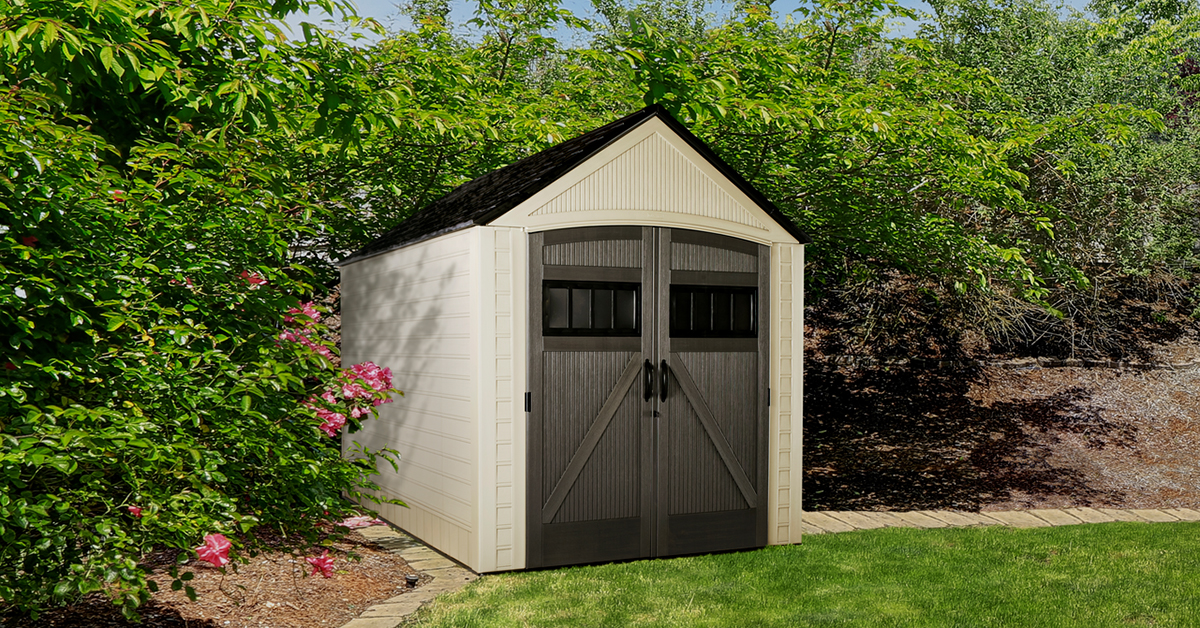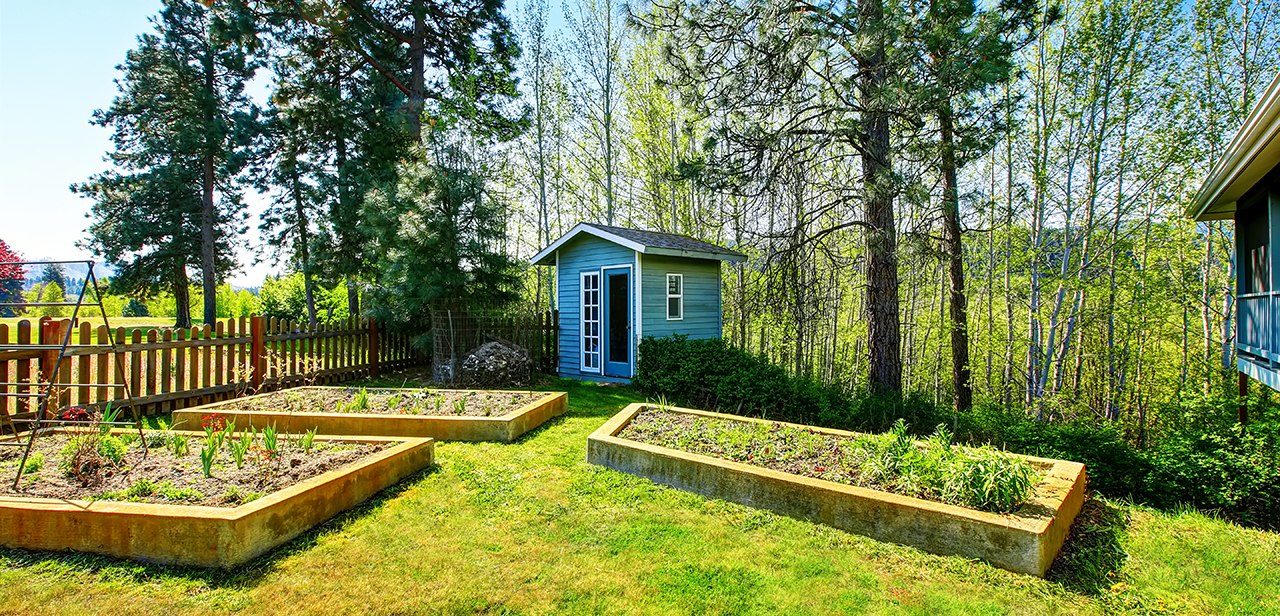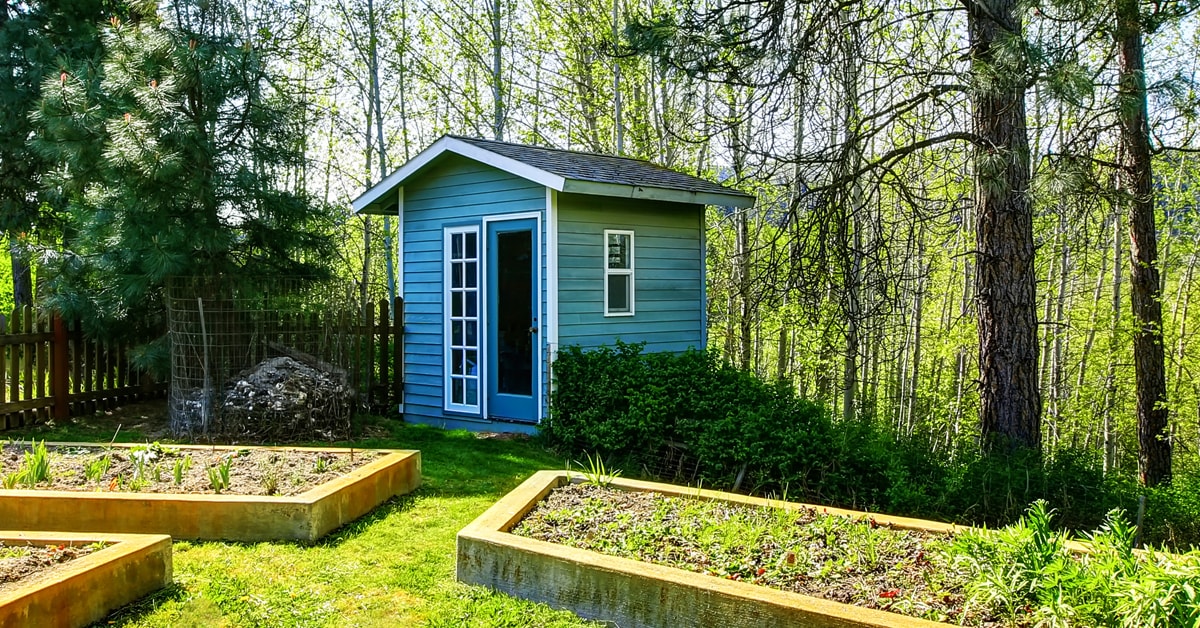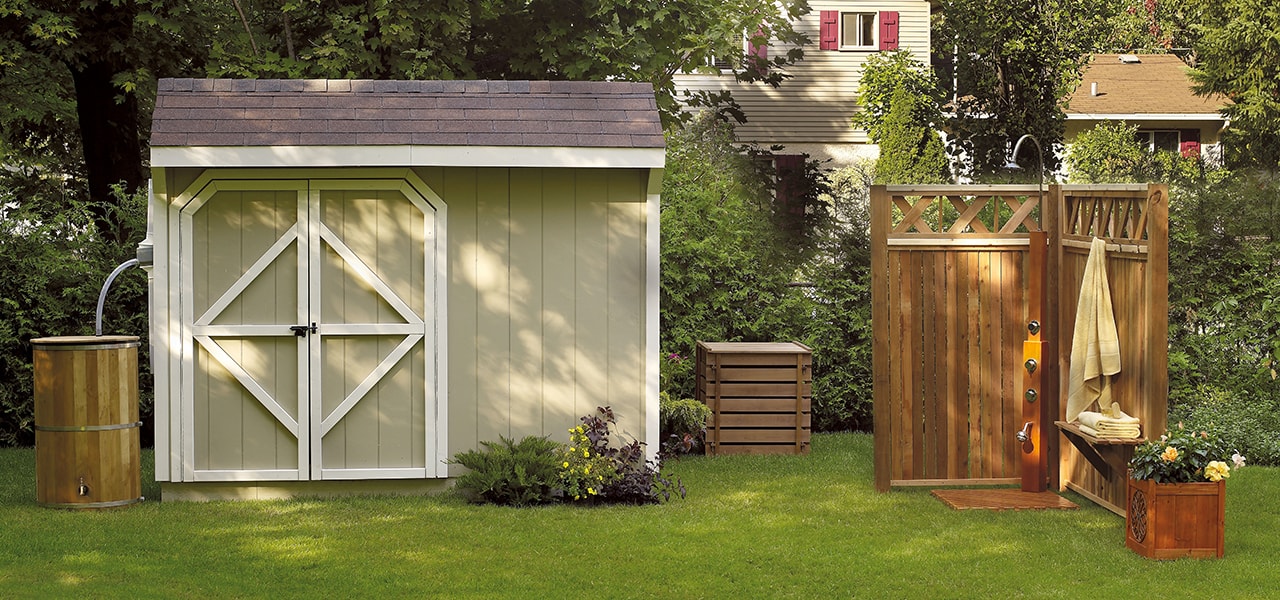
Updated on December 22, 2023
Choose the Right Storage Shed for Your Backyard
You can’t park in the garage anymore thanks to gardening tools, outdoor power equipment, patio furniture, bikes, and more? Consider this practical solution to declutter your living space: a storage shed for your backyard! Whether you’re buying or building, here’s everything you need to know about garden sheds.
Before You Start

1Identify Your Needs
- How will you use your shed? Storage, workspace, or something else?
- How will moisture, soil, slope, fencing, trees, property lines, or other elements on your lot affect the location of the shed?
- Is appearance important? Do you want your shed to match the architecture of your house or be a garden centrepiece?
- Does your neighbourhood homeowner’s association have rules governing the placement, dimensions, or aesthetics of a shed?

2Choose the Right Location for Your Shed
- Property lines: Review a current survey. It should list all boundaries, structures, fence lines, encroachments, and easements. Walk your property and compare what you see with what’s listed on the survey. You don’t want to make the mistake of building a shed that straddles a property line, sits within a drainage or utility easement, or violates local property setback requirements.
- Obstacles: Will trees, hedges, wires, a septic bed, rocks, water, or other obstacles interfere with construction, clearance, or access? Consider how the landscape and surrounding foliage may change throughout the year and over time.
- Utilities: Call local authorities to identify utility lines near your building site.
- Grade and soil: Ideally, you want a level site with good drainage and firm soil. Building your shed on a grade or at the bottom of a hill can lead to moisture problems, including mould and mildew on items stored inside. If your site slopes steeply (more than 12" from one side to the other), or drainage is an issue, you’ll need an appropriate foundation.
- Aesthetics: How would the shed look from a neighbour’s vantage point? If you belong to a neighbourhood homeowners association, are their rules governing the placement, dimensions, or aesthetics of a shed?
- Other considerations: Proximity to water, electricity, or propane; natural light; ventilation; the ability to deliver construction materials to the site; and space for a ramp if you’re planning to store a lawn mower or other rolling equipment.
3Obtain the Necessary Permits
- Do I need a permit? Only your local building office can say for sure. Each municipality has its own codes and zoning ordinances, so check before you make decisions on the size, location, and style of your shed.
- How do I apply for a permit? Expect to submit a building plan that includes dimension and elevation drawings, the location of your building site on your property, and a list of materials.

4Pick the Right Shed Size
- Gather all the items you would like to store inside your storage shed: lawnmower, bikes, shelving units, workbench, etc.
- Lay these items out on a square on the ground. Make sure there is plenty of clearance for you to navigate and rearrange the items within. We suggest adding 12 to 36" of extra space to allow for walking.
- Using a tape measure, measure how much space these items occupy as they rest on the ground.
The results will help you determine the floor space required and size of a shed you will need. Note that if your shed will also be a workspace—a potting shed, workshop, studio, pool shed, etc.—you’ll need room for storage and for you to move around or work.
If you conclude from your measurements that your items will fit precisely into a 10’ x 10’ shed, we recommend upgrading to the next size. As a general rule, most people run out of floor space before wall space, so it is important to plan ahead. As your collection of equipment grows over the years, the extra storage space will come in handy.
Buying a larger garden shed may have a higher initial cost but consider it a long-term investment. You will be purchasing new tools and equipment over time, and if you run out of space, you will either need to replace the old shed or buy an additional one. By planning ahead, you will maximize the lifespan of your garden shed.
5Build a Solid Foundation
There are 2 basic types of foundations for a small to medium-sized shed:
- On-grade foundation: An on-grade foundation sits on top of the ground. It can be as simple and economical as a frame of pressure-treated timbers or concrete pavers and works well on level, sturdy soil.
- Permanent foundation: This is a series of concrete piers that extend below the frost line topped by a frame of pressure-treated timbers. This type of foundation may be more work to build, but it’s permanent and ideal for parts of Canada where frost heave is an issue.

6Select the Type of Material You Want
Storage sheds are available in a variety of materials, and each comes with their own pros and cons. Evaluate each option to choose the one best suited to your needs.
| Pros | Cons |
Vinyl / Plastic | · Budget-friendly · Fast and easy to assemble · Requires no regular maintenance · Resistant to insects
| · May require specialized shelving and wall hooks for organization inside · Doors are less secure than other types of sheds · Material may be susceptible to UV rays and snow loading · Limited size, style, and appearance choices |
Resin | · Budget-friendly · Fast and easy to assemble · Requires no regular maintenance · Resistant to insects · Weather resistant | · Needs to be anchored to a base · Can bear limited weight on their walls · Pricier than metal sheds |
Galvanized Steel | · Available in various sizes, designs, and colours · Relatively easy to assemble with a few basic tools · Requires no regular maintenance · Fire, insect, and rot-resistant | · Hard to customize · Noisy in the wind and rain · Difficult to repair · Needs to be anchored to a base · Not resistant to rust |
Wood | · Strong and durable · Visually appealing · Available in a wide range of sizes, designs, and accessories · Easy to customize inside and out | · Requires moderate carpentry skills and tools; assembly time may take several weekends depending on your skill and tools · Kits typically do not include roofing shingles, paint or stain, or foundation materials · Not insect, fire, or weather-resistant · High maintenance |

7Pick a Shed Style that Complements Your Backyard
8Enough Said, Let’s Install a Shed!
1. Use a Shed Kit
Building your dream shed may seem like a challenge at first, but kits are relatively simple to install and can be built within 6-10 hours depending on the size.
Most wooden backyard sheds are sold as kits, where the shed arrives in pieces that you can put together with minimal building experience or special tools. Kits come in 2 different formats:
- Pre-cut: A pre-cut kit includes all the materials you need, cut to length and ready to assemble. Roof trusses may be pre-assembled, saving you the effort.
- Pre-assembled: Major structural components such as walls, trusses, and the floor are built and framed for you and arrive on site ready to put together. Windows and doors are framed so they go in easily. Pre-assembled shed kits are designed for construction in a couple of days, but still require careful site preparation and an appropriate foundation. Also, because the pieces are heavy, most people need at least one helper on site.
If a ready-made shed or kit won’t do, you can buy construction plans that you can follow and modify to meet your specific needs. When you work from an original plan, the biggest challenge is calculating the cost to purchase materials and the time to complete your project. That’s why your plan should contain as much detail as possible, including:
- Material list
- Materials cut list
- Dimensions and elevation drawing
- Step-by-step instructions
- Detail drawings
- Mechanical drawing
3. Get Help from Qualified Professionals
However, if your time is limited, consider having your garden shed installed by one of our outdoor specialists. Learn more about our installation services!



















